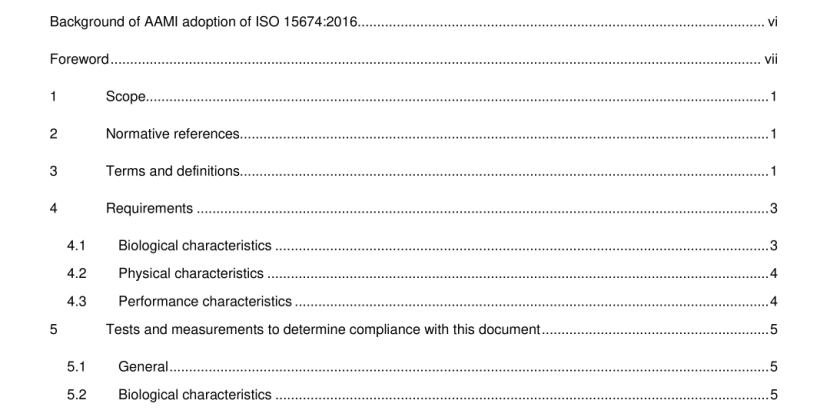ANSI AAMI ISO 15674-2016 pdf download
ANSI AAMI ISO 15674-2016 pdf download.Cardiovascular implants and artificial organs— Hard-shell cardiotomy/venous reservoir systems (with/without filter) and soft venous reservoir bags
5.2.2 Biocompatibility
Compliance shall be verified by inspection of the manufacturer’s documentation on biocompatibility for the finished device in accordance with ISO 1 0993-1 and ISO 10993-7. 5.3 Physical characteristics
5.3.1 Blood pathway integrity for soft venous reservoir bags
Subject the blood pathway of the device, filled with water, to a positive pressure of 1 .5 × the manufacturer’s rated pressure or, if none is given, to a pressure of 1 52 kPa (22 psi) gauge and maintain this pressure for 6 h or for the intended time of use specified by the manufacturer. Visually inspect the device for evidence of water leakage.
5.3.2 Blood pathway integrity for sealed hard-shell reservoirs
5.3.2.1 Perform the test with air or water at the appropriate pressures.
5.3.2.2 Subject the blood pathway of the device to a negative or positive pressure of 1 .5 × the manufacturer’s rated pressure and maintain this pressure for 6 h or for the intended time of use specified by the manufacturer. Using air pressure decay or visual inspection, check for evidence of leakage. NOTE If the hard-shell reservoirs are only operated at atmospheric pressure, the test for blood pathway integrity needs to be performed at atmospheric pressure on these units.
5.3.3 Connectors
The connection shall be made in accordance with the manufacturer’s instructions for use. The connection shall withstand a pull force of 15 N for 1 5 s without separating.
5.3.4.1 Test media
The test liquid for the blood pathway shall be anticoagulated whole blood.
5.3.4.2 Procedure
Two sets of appropriate, identical circuit components, including a pump, connecting tubing, a reservoir (as specified by the manufacturer and of suitable size relative to the device under test) and a heat exchanger, shall be assembled. The device under test shall be placed in one of the circuits. A predicate device shall be placed in the second test circuit. Priming and debubbling of the circuits by recirculating with an appropriate solution is recommended before blood is added. The blood pathway test-liquid volumes shall, at the initiation of the test, be within 1 % of each other. Perform the test in vitro using the conditions given in Table 1 . A sufficient number of paired tests should be performed to support a statistical analysis. The predicate reservoir should be tested under the same conditions.
5.3.5.1 Test liquid
The test liquid shall be a glycerin solution or water. The test liquid shall contain 350 particles per ml to 5,000 particles per ml that are 1 5 % to 25 % larger than the nominal pore size of the reservoir filter.
5.3.5.2 Procedure
Pass 500 ml of the test liquid at room temperature (20 °C to 22 °C) through the reservoir filter at a flow rate of no less than 100 ml/min and a pressure not exceeding 1 52 kPa (22 psi) gauge. Determine the pre- and post-filtration mean number of particles. The test shall be performed at the manufacturer’s recommended flow rates. Calculate the filtration efficiency, using the readings from the size range of the test particles used for each test sample, by subtracting the post-filtration mean number of particles from the pre-filtration mean, dividing the quotient by the pre- filtration mean number of particles, and multiplying by 1 00 to obtain a percentage.
5.3.6 Shelf life Using a validated method, ageing should be performed on final, finished, sterilized, devices in primary packaging in order to determine nominal shelf life.
6.2.1 Information on the unit container
The following shall be given on the unit container:
a) the manufacturer’s name and address;
b) description of contents;
c) model designation;
d) statement on sterility and non-pyrogenicity;
e) batch, lot or serial number designation;
f) the statement “Read instructions before use” or equivalent symbol;
g) special handling or storage conditions;
h) statement on single-use;
i) expiry date.
